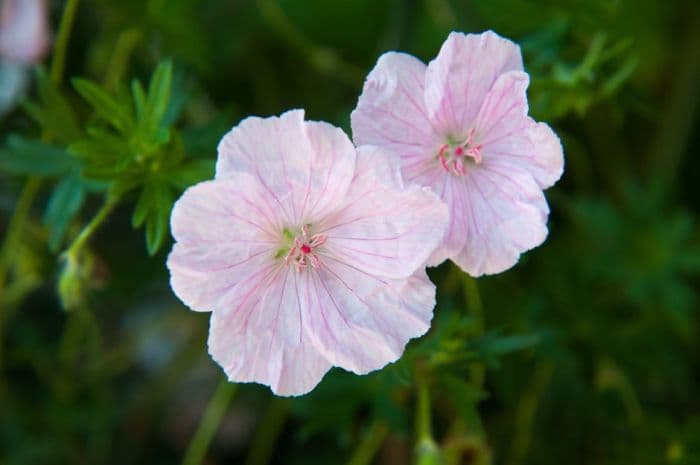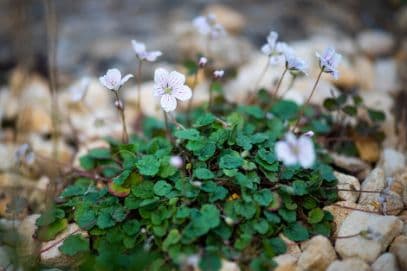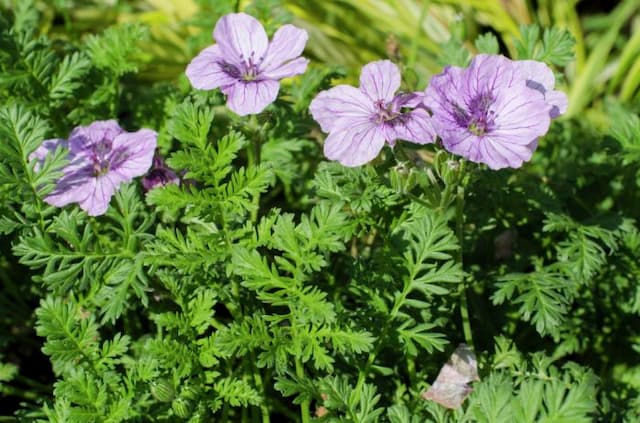Bloody Cranesbill Geranium sanguineum var. striatum

ABOUT
The plant you're referring to is commonly known as the Bloody Cranesbill. This particular variety is characterized by its striking appearance with its soft-pink to lilac flowers. These flowers are delicately veined, providing a beautiful striped pattern that catches the eye. Each bloom is rounded, typically sporting five petals that spread outwards and create a cupped shape. The center of these flowers hold conspicuous dark pink stamens that contrast with the lighter petals. The foliage of Bloody Cranesbill is equally attractive. The leaves are deeply lobed and have a dense, bushy growth habit forming a mound of greenery. These leaves often show hints of reddish color, particularly as they mature or when the temperature drops. During the fall, the foliage can turn a reddish shade, adding another layer of visual interest to the plant. Throughout the blooming period, which spans late spring to early summer, the Bloody Cranesbill continuously produces these stunning flowers, yielding a long-lasting display of color. The flowers and the foliage combined make this plant a delightful choice for garden borders, rock gardens, or as ground cover where its aesthetic qualities can be appreciated up close.
About this plant
 Names
NamesFamily
Geraniaceae
Synonyms
Bloody Cranesbill, Striped Bloody Cranesbill
Common names
Geranium lancastriense, Geranium sanguineum var. prostratum, Geranium sanguineum var. lancastriense.
 Toxicity
ToxicityTo humans
The common name for Geranium sanguineum var. striatum is Bloody Cranesbill. This plant is not considered toxic to humans. It doesn't contain any known harmful substances that would cause poisoning if ingested. Consequently, there are no specific symptoms of poisoning associated with the Bloody Cranesbill due to its non-toxic nature.
To pets
The common name for Geranium sanguineum var. striatum is Bloody Cranesbill. The Bloody Cranesbill is generally considered safe and non-toxic to pets. There should be no concerning symptoms of poisoning in pets from ingesting any part of this plant. However, as with any non-food item, if a pet ingests a large amount of plant material, it could potentially lead to gastrointestinal upset, such as vomiting or diarrhea, as a result of the physical irritation rather than toxicity.
 Characteristics
CharacteristicsLife cycle
Perennials
Foliage type
Deciduous
Color of leaves
Green
Flower color
Pink
Height
1 foot [30 cm]
Spread
1-1.5 feet [30-45 cm]
Plant type
Herb
Hardiness zones
4
Native area
Europe
Benefits
 General Benefits
General Benefits- Attractive Ground Cover: Geranium sanguineum var. striatum, commonly known as Bloody Cranesbill, forms a dense mat of foliage, providing an aesthetically pleasing ground cover that suppresses weeds.
- Low Maintenance: Bloody Cranesbill is known for being a hardy and drought-resistant plant, requiring minimal care once established.
- Attracts Pollinators: The striking flowers attract bees, butterflies, and other pollinating insects, supporting biodiversity.
- Colorful Blooms: Produces delicate pink flowers with veined petals that add color and beauty to garden spaces.
- Tolerance of Various Soils: Can thrive in a range of soil types, from sandy to clay, making it a versatile choice for gardeners.
- Natural Erosion Control: The dense growth of Bloody Cranesbill can help prevent soil erosion, especially on slopes or in erosion-prone areas.
- Seasonal Interest: Offers visual interest from late spring to early fall, with peak blooms occurring in late spring and early summer.
- Edging Plants: Its compact growth habit makes it suitable for use as edging along paths or garden borders.
- Wildlife Habitat: Can provide shelter and habitat for small creatures within a garden ecosystem.
- Easy Propagation: Can be easily propagated through division, making it simple to expand or share with other gardeners.
 Medical Properties
Medical Properties- Anti-inflammatory: Geranium sanguineum var. striatum may possess anti-inflammatory properties.
- Astringent: The plant has astringent qualities, making it potentially useful in toning the skin and mucous membranes.
- Diuretic: It might be utilized for its diuretic effects, facilitating the removal of excess water from the body.
- Hemostatic: The plant is traditionally used for its hemostatic properties, which help to reduce or stop bleeding.
 Air-purifying Qualities
Air-purifying QualitiesThis plant is not specifically known for air purifying qualities.
 Other Uses
Other Uses- Geranium sanguineum var. striatum, also known as Bloody Cranesbill, can be used as a natural dye source, offering hues ranging from subtle grays to vibrant reds, depending on the mordant used.
- The dried and crushed leaves of the Bloody Cranesbill can be infused into oils to create fragrant potpourris or natural sachets that emit a pleasant aroma.
- The plant can also serve as a ground cover in landscaping, helping to prevent soil erosion thanks to its dense foliage and spreading habit.
- Not commonly known as a food item, tender young leaves of the Bloody Cranesbill can be added in small quantities to salads for visual appeal, although they are not widely recognized for their taste.
- Its vibrant flowers are often used in ornamental crafts, such as pressing for bookmarks or decorative cards.
- The root system of Bloody Cranesbill can be utilized in stabilizing riverbanks and streamsides since it can withstand occasional flooding and helps to bind the soil.
- Some gardeners use the plant as a living mulch to populate the base of larger shrubs or trees, thereby minimizing weed growth and retaining soil moisture.
- The thick foliage provides habitat and refuge for small garden wildlife including beneficial insects and pollinators.
- The unique texture and form of the leaves can be used as inspiration or actual templates in various forms of art, such as eco-printing on fabrics.
- Finally, their robust and adaptable nature makes Bloody Cranesbill plants suitable for use in educational projects about native planting and biodiversity.
Interesting Facts
 Feng Shui
Feng ShuiThe Bloody Cranesbill is not used in Feng Shui practice.
 Zodiac Sign Compitability
Zodiac Sign CompitabilityThe Bloody Cranesbill is not used in astrology practice.
 Plant Symbolism
Plant Symbolism- Unexpected Friendship - Geraniums can symbolize a surprise encounter with someone who becomes a friend.
- Good Health - Often associated with wellbeing and a wish for good health due to its medicinal properties.
- Folly or Stupidity - In some folklore, geraniums are also linked to folly or foolishness, perhaps due to their bold appearance.
- True Friendship - They represent deep and true friendship, especially the striated variety for its enduring beauty.
 Water
WaterFor the Bloody Cranesbill, watering should be thorough, allowing the soil to completely soak and then dry out between watering sessions. Typically, watering once a week is sufficient, but during particularly hot or dry spells, watering might be needed more frequently. The amount of water should be adjusted according to the season and the weather conditions, but on average, using about 1 gallon per plant for each watering should be adequate, ensuring not to waterlog the soil. In winter, reduce watering to prevent root rot in cooler temperatures.
 Light
LightThe Bloody Cranesbill thrives best in full sun to partial shade conditions. It should be placed in a spot where it receives at least 4 to 6 hours of sunlight daily. While it can tolerate some shade, too little light can lead to leggy growth and fewer blooms, so selecting a location that receives morning sunlight with some afternoon shade is often ideal.
 Temperature
TemperatureBloody Cranesbill is hardy and can withstand temperatures as low as 20°F and as high as 85°F. The ideal growing temperature range for this plant is between 60°F and 75°F. It's crucial to protect the plant from frost and excessive heat, as prolonged exposure to temperatures outside these ranges can damage or kill the plant.
 Pruning
PruningThe Bloody Cranesbill should be pruned to remove spent flowers and encourage bushier growth and more blooms. It's best to prune it lightly throughout the growing season as needed, and then cut it back more significantly after the first frost to prepare it for winter. The best time for major pruning is in the late winter or early spring before new growth begins.
 Cleaning
CleaningAs needed
 Soil
SoilThe Bloody Cranesbill thrives in well-draining soil with a mixture of loam, compost, and sharp sand to ensure adequate drainage and fertility. The soil pH should be neutral to slightly alkaline, ranging from 6.5 to 7.8.
 Repotting
RepottingThe Bloody Cranesbill doesn't require frequent repotting and does best when left undisturbed. Repotting is generally needed only if the plant has outgrown its current container, which typically occurs every 3 to 4 years.
 Humidity & Misting
Humidity & MistingThe Bloody Cranesbill prefers moderate humidity levels. While it can tolerate some variation, it does not require specific humidity adjustments when grown outdoor in its preferred temperate conditions.
 Suitable locations
Suitable locationsIndoor
Ensure bright light and well-draining soil mix.
Outdoor
Plant in sun to part shade, enriched, well-draining soil.
Hardiness zone
4-8 USDA.
 Life cycle
Life cycleGeranium sanguineum var. striatum, commonly known as Bloody Cranesbill, begins its life cycle with seed germination, which typically occurs in spring when conditions are favorable with warm soil and available moisture. The seeds develop into small rosettes of leaves and, given sufficient sunlight and nutrients, the plants enter the vegetative stage, growing stems and more leaves. As the plant matures, it enters the flowering stage in late spring to early summer, producing distinctive pink to purple flowers with dark veins, which are important for attracting pollinators. Following pollination, the plant sets fruit in the form of a beaked capsule, containing seeds which are dispersed by the explosive dehiscence mechanism when ripe. During fall, Bloody Cranesbills prepare for dormancy, with above-ground growth dying back and energy being stored in the root system to survive the winter. The plant remains dormant throughout the cold months until environmental cues trigger the cycle to begin anew with the return of spring.
 Propogation
PropogationPropogation time
Spring-early summer
Geranium sanguineum var. striatum, commonly known as Bloody Cranesbill, is most commonly propagated through division, which is best done in either spring or autumn. To propagate by division, carefully dig up the parent plant, ensuring you keep a good amount of soil around the roots. Using a sharp spade or knife, split the plant into smaller sections, each with roots and shoots attached. Replant the divisions promptly, watering them well to establish. This method allows for the quick multiplication of plants while maintaining the parent plant's characteristics.




![Cranesbill [Blue Sunrise]](/_next/image?url=https%3A%2F%2Fplants-admin.emdemapps.com%2Fimages%2Fplants%2F%2Fimages%2F604b638d45948.png&w=640&q=75)




